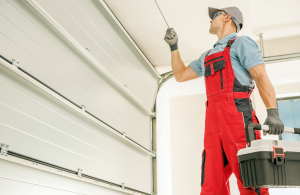Your garage door is one of the largest outdoor appliances your home has. With such a large appliance comes great responsibility. Such great responsibility can be easy to forget, such as your garage door seals. Did you know that there are different types of garage door seals that you could choose from and that each comes with specifics that another may not? If you have specific goals to keep bugs, dirt, water, or even grass from entering your garage, then buckle up and keep reading our informational blog to learn what garage door seal may suit your goals better!
What Do Garage Door Seals Do?
Before we jump into the different types of garage door seals, we should go over what garage door seals can do. The seal can act as another form of security, as it helps to close any and all gaps around your garage door. In addition, these seals can protect your vehicles or anything else you may have in your garage from the elements. Such harm from rain, hail, snow, and dirt could lead to damage or even mold if not taken care of properly. Think you need a garage door seal now? Let’s go over the different types now.
Reverse Jamb Angle Side Seal
Reverse jamp angle side seals are designed for rolling garage doors. These seals clip onto the perimeter of the garage door. Because this seal is clipped onto the inside of the garage door, you can expect to save more on energy bills while keeping out dirt, bugs, and the weather. You can also expect to save additional cost due to this type of seal not requiring a retainer and the vinyl lasting longer. Due to the vinyl this seal has, it retains its shape and doesn’t crack or warp.
Panel Weatherstripping
 Panel weatherstripping is specifically designed for garage doors that have panels. This style of seal has a V-shape to perfectly fit your garage door’s gaps. These seals give an additional layer of protection from the elements to the items you may have inside your garage.
Panel weatherstripping is specifically designed for garage doors that have panels. This style of seal has a V-shape to perfectly fit your garage door’s gaps. These seals give an additional layer of protection from the elements to the items you may have inside your garage.
Brush Seal
Brush seals, also known as garage door sweeps, can be an inexpensive way to maintain your garage while solving your garage door issues. Just like the reverse jamb angle side seal, this style of seal also goes along the perimeter of the interior. However, this seal can be used on both the bottom and the sides of the garage door. Brush seals are popular for garage doors that experience high activity levels, as they do not interfere with the overall functionality. You can expect this style of seal to keep your garage in pristine condition, with these seals having a 98.5 effectiveness rating.
Threshold seal
Threshold seals can be found at the bottom of your garage floor. These seals can be beneficial for both commercial and residential garage doors. These seals are particularly helpful at keeping water from entering your garage door. The downside to these seals is that if you have water in your garage, it could lead to a difficult cleaning process.
Vinyl Door Stop Weather-Stripping
Sometimes, you can expect your garage door to have gaps along the sides and top. Having these gaps can lead to a security problem for intruders to enter and lead to mold on the garage door. This seal can prevent any gaps and mold from occurring. You can use nails or screws to install it. You will know it is properly placed when it has a tight hold.
Bottom Seal

While this seal can be similarly compared to the threshold seal, as it keeps out rain and dirt, this seal has its difference in the way it connects to the garage door. In addition, this seal comes with a retainer channel which also makes it easier to replace the insert rather than the whole seal.
Let M.G.A Help With Your Garage Door Seal
Now that you have a guide to different garage door seals, it should be easier to pick the perfect one for your garage! Our team at M.G.A. Garage Door can help you select and install a seal. We can also help you with a wide variety of other garage door services. Whether it be repairs, replacements, or installation, we can do it all. So give us a call at (713) 936-2255.

